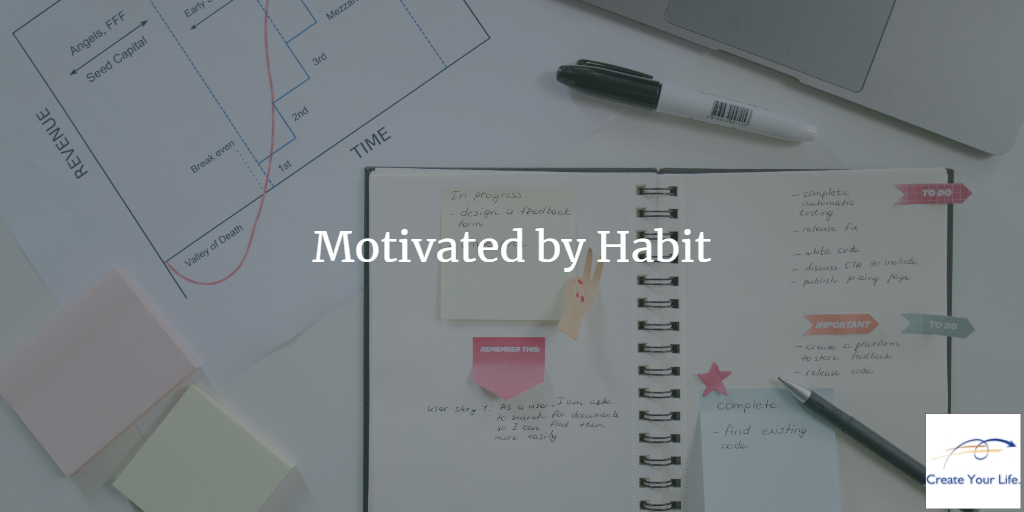When you are excited to begin a new project or to start work on a BIG goal, motivation is high. Use that energy. It’s what gets you started. But use it to build new habits that keep you moving in the right direction. That’s what keeps you going. Tap into the power of motivation and the power of habits.
A Tale of Two Mornings
On a bright Monday morning, the alarm clock blared its familiar tune. Janet leaped out of bed, ready to start the day. She hit the ground running, her morning routine like a well-choreographed dance. After a brisk jog, a nourishing breakfast, and a few minutes of meditation, she was ready to tackle her work with enthusiasm.
In another neighborhood just a few blocks away, Jason’s alarm clock sounded the same cheerful tune. But his response was quite different. He didn’t hit the ground running . . . he hit the snooze button for the third time, groaning at the thought of another workweek. Rushing to get dressed and grabbing a pastry on his way out the door, he sighed at his morning reflection in the car’s rearview mirror.
Janet and Jason lived parallel lives, with similar aspirations, dreams, and goals. Yet, the difference in their daily routines was like night and day. Janet had cultivated habits that motivated her to seize each day, while Jason’s unproductive morning rituals left him in a perpetual state of catch-up.
This tale of two mornings illustrates the power of habits and motivation. It’s a story that unfolds in countless variations across the world, highlighting the choices we make and how they shape our lives. As we delve into the dynamics of habits and motivation, let’s discover how simple actions and shifts in mindset can lead to a lifetime of success.

Getting Started
“Motivation is what gets you started. Habit is what keeps you going.” ~ Jim Ryun
Motivation pushes us to achieve, to set BIG goals (and not-so-BIG goals, which is OK). Motivation gives us the drive to get up and get moving. But as someone (I think it was me, in fact) once said, “Motivation is a sketchy sort of character – you can never depend on it being there when you need it.” Motivation fluctuates. In my experience, it usually starts strong but wanes over time. And unfortunately, sometimes it never even shows up.
Many goals involve doing certain activities at specific, repeated intervals. According to Wendy Wood and Jeffrey M Quinn: “This regularity in motivated behavior organizes everyday experiences into repeated patterns of goal-directed activities in particular circumstances. With repetition of behavior in stable contexts, actions become automatic in the sense that deliberation about behavior becomes unnecessary. These well-practiced behaviors represent habits . . .” [Forgas, et al.]
Motivation can get us started, but it’s habit that keeps us going. We must turn those actions that we are motivated to perform into habits, so we keep doing them even when the motivation is no longer there.
The Motivation Factor
“The pain of not doing it is worse than the pain of doing it.” ~ Steven Pressfield
When doing a thing becomes easier than not doing it, as Pressfield said, we become motivated to change. This is motivation in a nutshell.
Has this ever happened to you? You have a project for work or a term paper to write for a class but it isn’t due for several weeks. At first, it’s easy to put off and you do nothing. The pain of doing it outweighs not doing it. But as the deadline draws closer, there is a shift. Eventually (and hopefully not the night before) it becomes more painful not to do it, so the report or the paper gets written.
In a sense, motivation is like willpower. It isn’t that you either have it or you don’t. Instead, it fluctuates. It can be strong sometimes and practically nonexistent at other times
Leon Ho, writing in Lifehack tells us that motivation comes in layers.
It begins at our core, with our purpose. [Ho] Your purpose and your goals are the force from which your motivation arises.
Other “layers” of motivation are acknowledgment and support. [Ho] Acknowledgment includes external factors that we find motivational – recognition, praise, respect, and support from others are included in this layer. Support comprises the elements that reinforce your efforts. These include the people and resources that enable you to strive for your goals.
While support and acknowledgment are necessary, it is your purpose that powers your motivation. If your goal has little meaning or value, it almost goes without saying that your motivation to work toward that goal will be low. But when you have a purpose, you are motivated to form the routines and the habits that will keep you in the race, keep you moving toward your goal.
The Power of Habits
The people who consistently achieve success and reach their goals have learned the importance of having a routine. [Growth Faculty] Routines remove the need to make a decision again and again. If you had to think about and decide on everything you did every day, about getting dressed, or driving, or when to eat, etc., etc., most of your mental capacity would be taken up by these mundane but necessary activities. Fortunately, we have the power of habit to take over most of these things, most of the time. By establishing routines, you make the decision once then let the routine, and eventually the habit, take over.
We hear folks say, time and again: “I’m just not motivated to walk every day” or “to write every day” or “to cook healthy meals” or a thousand other things people say they want to do. Even if they are motivated enough to start to make a change, they usually do the thing once or twice, then they drop it.
This is where the power of habits lies. Instead of waiting for motivation, which we’ve already seen is unpredictable and unreliable, we are more likely to be successful by building consistent habits. [Guha]
Research shows that up to 45% of our actions are automatic, driven by habit. [Wood] Most of these are our daily activities and most of the time we don’t even notice them. But habits can be used to automate your best behaviors. Willpower and motivation, as we’ve seen, are unreliable at best. You’ll have more success when you create habits, and then rely on your habits to automate your behavior.

How Habits and Motivation Interact
When motivation is high, you are more likely to perform an action or behavior, even if it is a challenge to your abilities. But the harder a behavior is to do, the less likely you are to do it, and the more motivation you need. [Fogg]
It is nearly impossible to stay motivated for long periods of time, especially if we find the behavior difficult to do. [Shihab] By making the desired behavior easier to do, such as breaking an action into tiny steps as we do when creating mini habits, we decrease the need for motivation.
Then, as we continue to perform the tiny steps over time, we turn the desired behavior into a habit. It becomes automatic and we no longer need motivation. Plus, if it’s a beneficial habit that we’ve consciously created, that can be motivational in itself. [Ho] It gives you a sense of accomplishment, provides positive feedback and reinforcement, and increases self-discipline. This provides intrinsic motivation, so that you perform the behavior, not for any external reward, but because you simply enjoy the activity and the good feelings it brings.
Strategies for Building Positive Habits
From Mini Habits to Tiny Habits to Atomic Habits, you and I frequently talk about the power of habits and how to create habits. Basically, you put the so-called habit loop to work. These are the four components required to create a habit: a cue or trigger, a craving that makes the behavior attractive, the response to the cue, and a reward for performing the behavior. [Clear]
- The cue is anything that prompts you to take action. This could be a desire inside yourself (the least reliable), something in your environment, or an action that you already do, as in habit stacking.
- Craving is your motivation to change – no craving, no motivation.
- Response is the behavior you want to make into a habit.
- Reward is the (temporary) satisfaction of the craving.
According to James Clear, these are the requirements for creating a new habit. [Clear]
Make it obvious. Select a prompt that is obvious and reliable. The best way is to tie it to an existing behavior but you could also use a prompt in your environment (i.e., a context prompt).
Make it attractive and desirable. Without a craving, a desire, there is no motivation to act; you engage in a habit because of the good feeling you anticipate you will have afterward.
Make it easy. To make it easy, use James Clear’s Two-Minute Rule for new habits. The Two-Minute Rule says to make the initial habit something that can be done in two minutes or less. Think of Stephen Guise who came up with the idea of minihabits by setting a goal to do 1 pushup.
Make it satisfying. Have a reward in place immediately when you complete the new behavior. Celebrate even the tiniest win!
You can find much more about creating habits in the Excelerated Habits™ blog posts at TheExceleratedLife.com.
Maintaining Motivation
An interesting fact about motivation is that it often comes after starting a behavior, not before. As we’ve talked about before, it is easier to act your way into feeling rather than waiting for feelings to drive your behavior. Do something. Do anything instead of waiting for motivation. Once you start, the motivation may show up.
An easy way to get yourself to act is to create a ritual. A ritual can help you “burn in” a new habit. Professional athletes are masters of using rituals to help them train and perform at their peak. You probably use rituals now for some highly ingrained habits, such as showering or brushing your teeth. It’s likely you never have to decide “Should I brush my teeth today”? You have a specific set of actions that you go through, probably without thinking about it. A ritual is made up of precise behaviors performed at specific times. It is necessary to commit to practicing the behaviors until they become second nature, so start very, very small. Make it something that is so ridiculously easy that you are certain to do it every day until it becomes a habit. Then you can branch out to more elaborate behaviors if you so desire.
When (not if) your motivation flags, remember, as James Clear tells us, that your mind is a suggestion machine. [Clear [2]] Therefore, consider any thought you have as a suggestion, not an order.
Your mind may suggest that you are too tired to take your daily walk. Or that you’re too busy to cook a healthy dinner. It may suggest that you’ll never accomplish your BIG goal – “it’s just too big!” But again, these are merely suggestions. If you’ll stop and consider, you’ll come up with other suggestions. Taking that walk will energize me. Eating healthy is a priority. I can reach my BIG goal by taking one small step after another and sticking with it. “Remember,” writes Clear, “none of these suggestions are orders. They are merely options.” [Clear [2]] You have the power to choose which option you take.
Don’t Wait for Motivation
“Usually the motivation that causes us to act is the result of our established habit patterns (vasanas in Sanskrit). This is cause and effect. We establish patterns of thought and reaction, and these, formed by ourselves, coerce us into acting in certain ways. So we have created the very force that molds us. Should we not be careful in our thoughts and the habits we create?” ~ Justin F. Stone
Motivation is essential to get you moving toward a desired change or in the direction of your chosen goal, but it is likely not enough to take you all the way. And so you must manage your motivation. Take advantage of it, but don’t depend on it.
When you are excited to begin a new project or to start work on a BIG goal, motivation is high. Use that energy. It’s what gets you started. But use it to build new habits that keep you moving in the right direction. That’s what keeps you going. Tap into the power of motivation and the power of habits. That is embracing your Excelerated Life™!
Which do you think is more important: habit or motivation?
Or maybe both?
Share your comments by leaving a post below.
Excelerated Habits™ — automating your best behaviors — is one practice for creating your Excelerated Life™, a life of flourishing and well-being, and a life of meaning, purpose, and service.
Read more about the Excelerated Life™.
Resources:
Clear, James. Atomic Habits: Tiny Changes, Remarkable Results. New York: Avery, an imprint of Penguin Random House LLC, 2018.
[2] Clear, James. “Motivation: The Scientific Guide on How to Get and Stay Motivated”. James Clear. James Clear, . Web. October 7, 2023.
https://jamesclear.com/motivation
Fogg, Ph.D., BJ. Tiny Habits: The Small Changes That Change Everything. New York: Houghton Mifflin Harcourt Publishing Company, 2020.
Forgas, J. P., Williams, K. D., & Laham, S. M. (Eds.). (2005). Social motivation: Conscious and unconscious processes. Cambridge University Press.
Growth Faculty. “How Your Daily Habits Build Motivation (Not the Other Way Round).” The Growth Faculty. The Growth Faculty, July 13, 2023. Web. October 7, 2023.
https://www.thegrowthfaculty.com/blog/habitsbuildmotivation#:~:text=This%20is%20where%20habits%20step,track%2C%20even%20when%20motivation%20wanes.
Guha, Ahona. “Instead of Waiting for Motivation, Build Habits.” Psychology Today. Sussex Publishers, LLC, June 20, 2021. Web. October 7, 2023.
https://www.psychologytoday.com/us/blog/prisons-and-pathos/202106/instead-waiting-motivation-build-habits
Ho, Leon. “Habits and Motivation: Master Both for Big Results.” Lifehack. Lifehack, May 21, 2019. Web. October 7, 2023.
https://www.lifehack.org/832555/habits-and-motivation#:~:text=Habits%20are%20Responsible%20for%20Motivating,distract%2C%20drain%20or%20demotivate%20us.
Shihab, Muhammad. “Motivation VS Habit.” LinkedIn. LinkedIn Corporation, June 24, 2023. Web. October 7, 2023.
https://www.linkedin.com/pulse/motivation-vs-habit-muhammad-shihab/
Wood, Wendy. Good Habits, Bad Habits. New York: Farrar, Straus and Giroux, 2019.
This blog post includes suggestions and research information provided by ChatGPT, an AI language model developed by OpenAI. The content was generated with AI assistance and is intended to provide information and guidance. Please note that the suggestions are not official statements from OpenAI. To learn more about ChatGPT and its capabilities, you can visit the OpenAI website.


